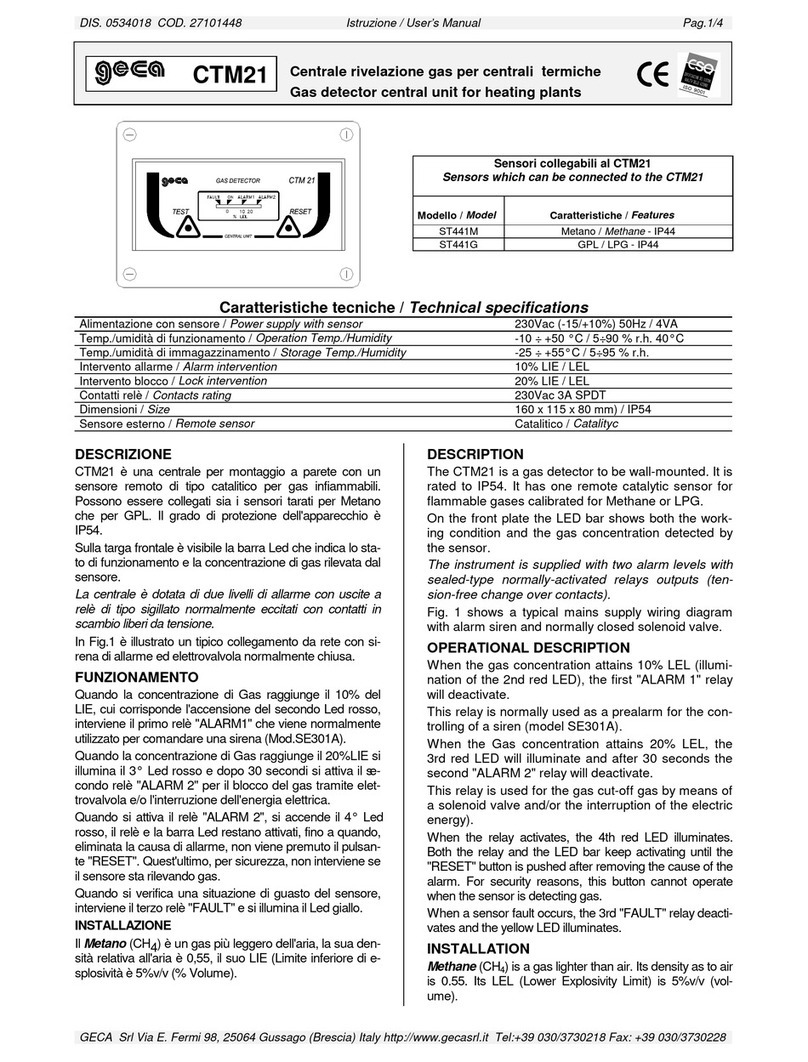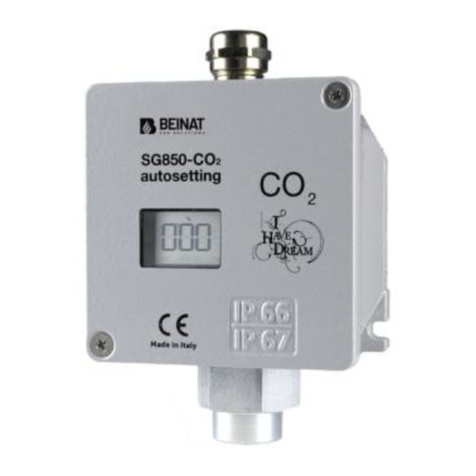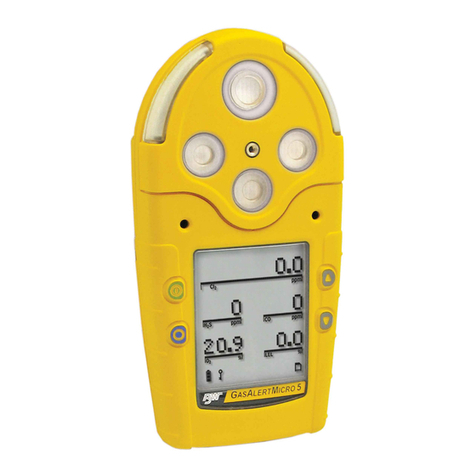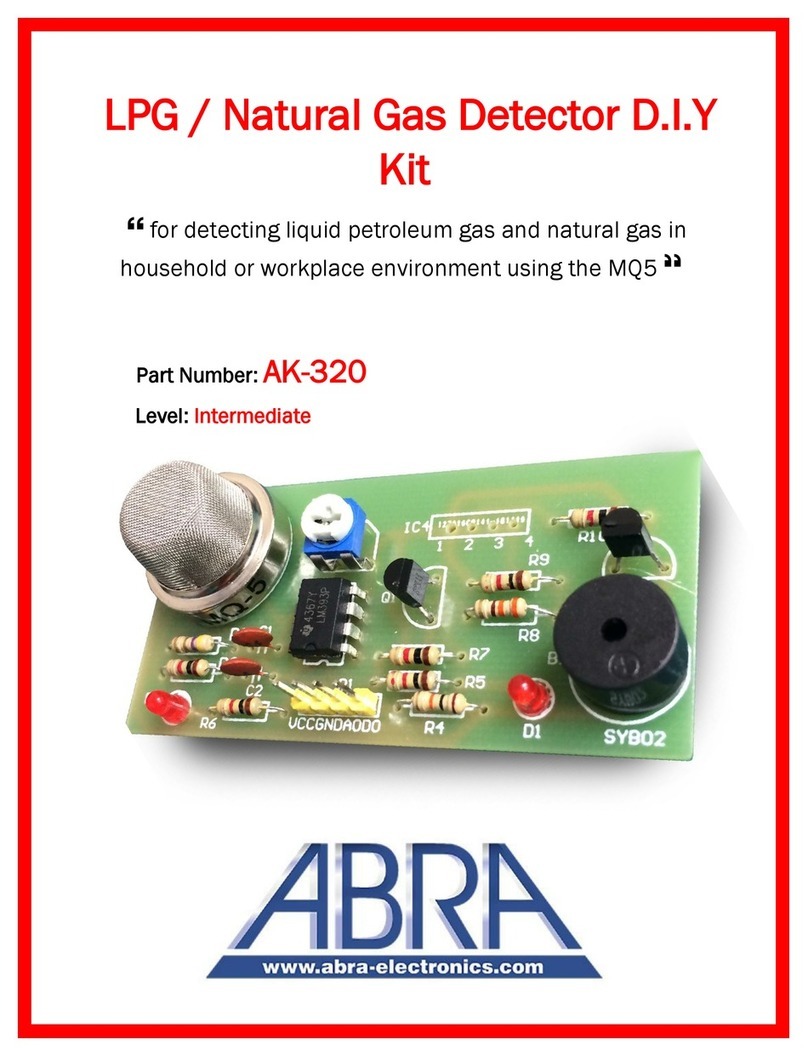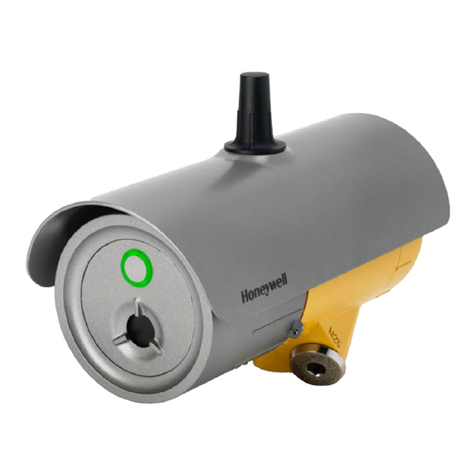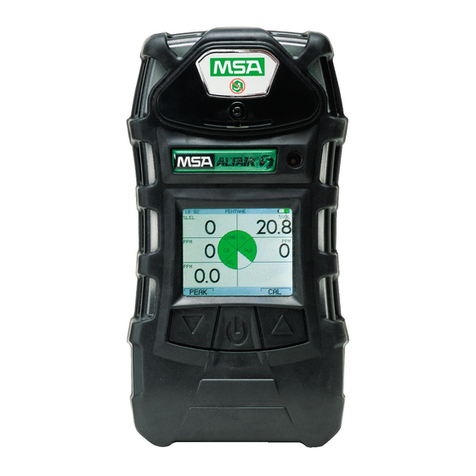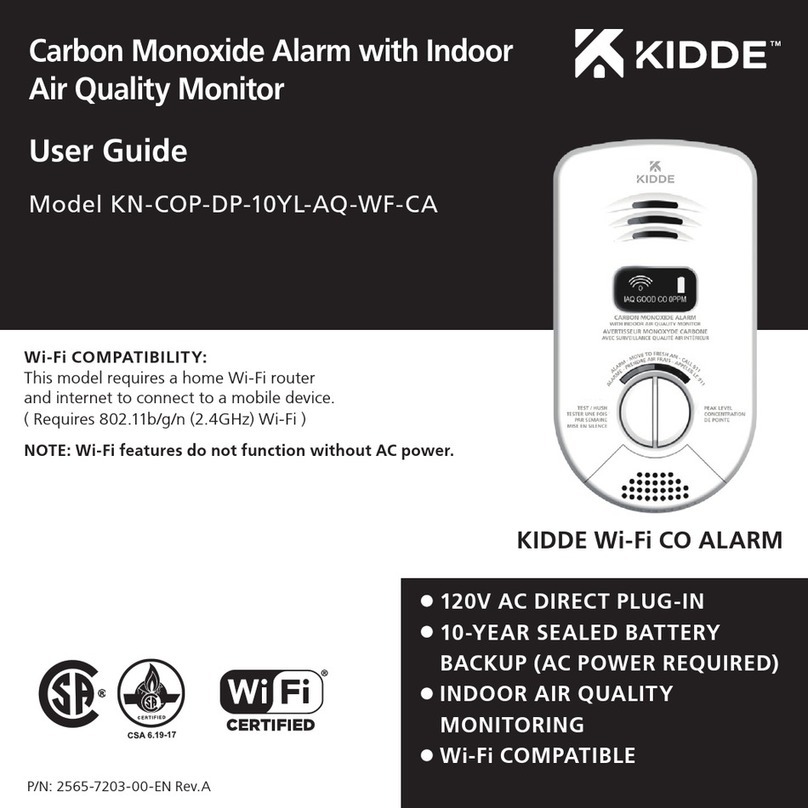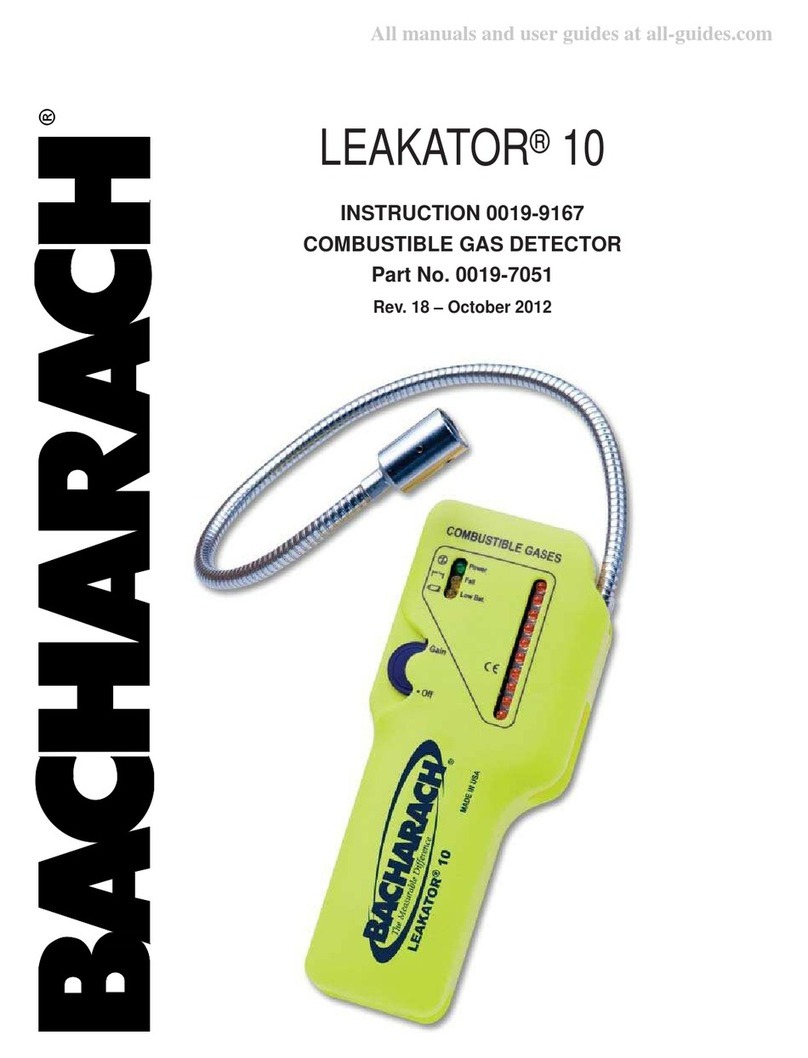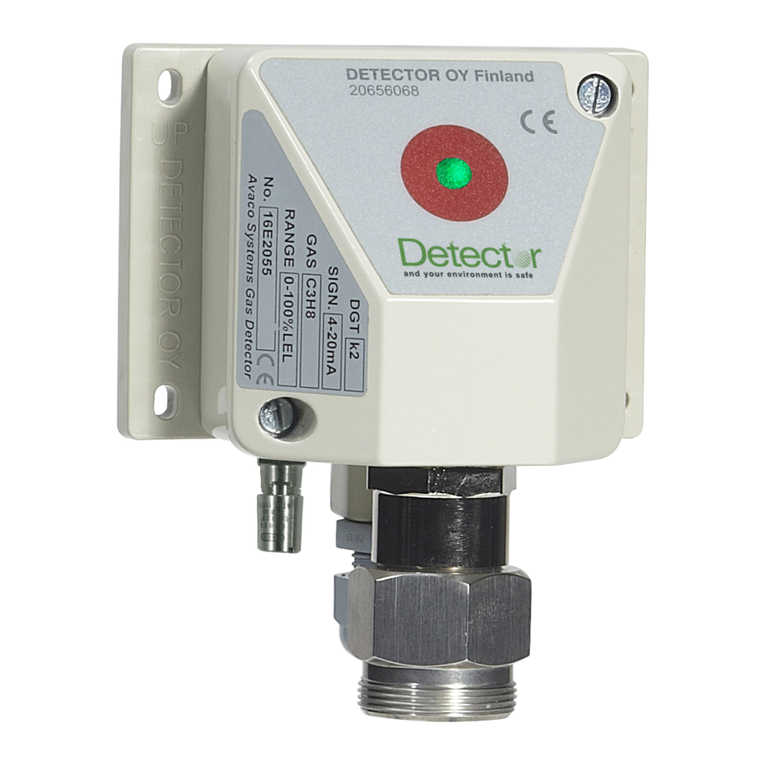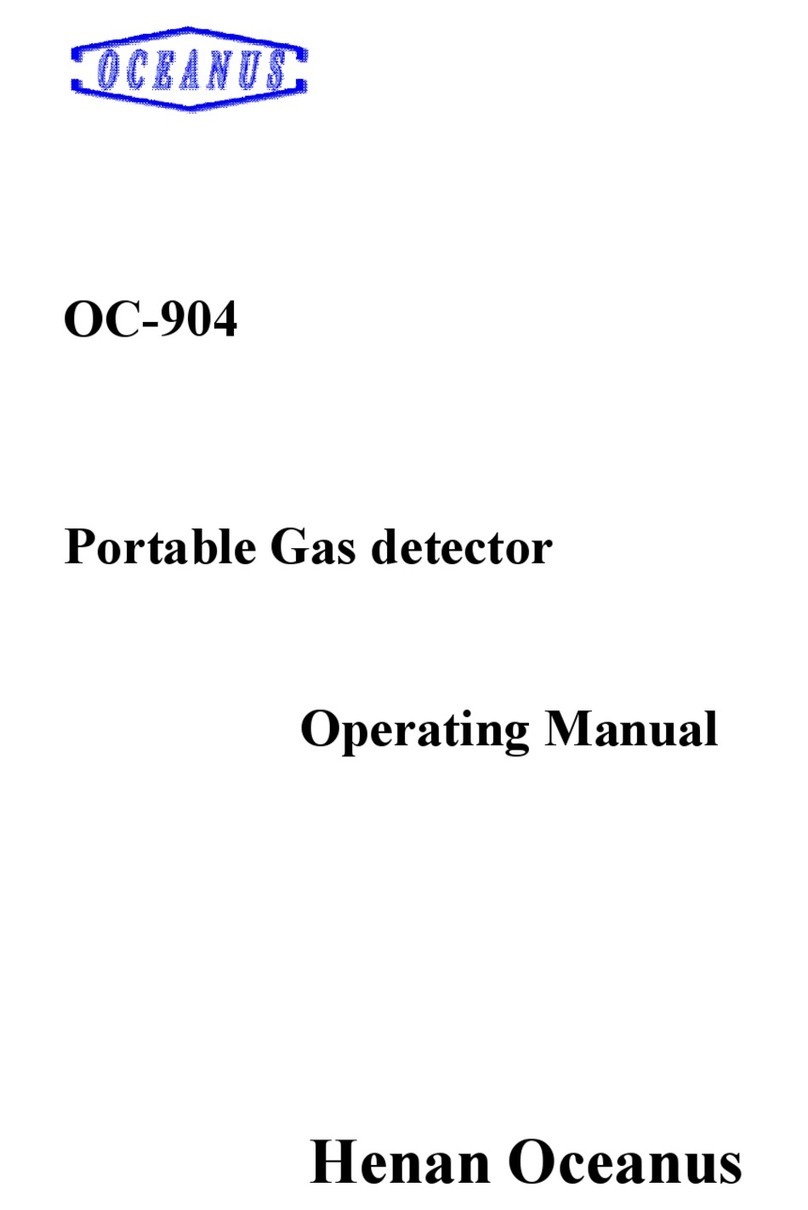Geca SE330K User manual

ELECTRICAL CONNECTION: POWER SUPPLY
Attention: undertrack cables are required to connect the instrument to the mains.
The gas detector must be powered at 230Vac 50/60Hz using terminals 1 and
2, or at 12Vdc using terminals 3 (+) and 4 (-). (Fig. 2).
A circuit breaker must be fitted that is able to disconnect the detector from the
power supply, with a contact distance of at least 3 mm, in accordance with the
European standard IEC EN 60335-1.
INSTALLING THE INSTRUMENT
The instrument MUST BE INSTALLED:
- In the case of Beta SE330KM and Beta SE333KM methane gas detectors,
CHARACTERISTICS OF THE OUTPUT SIGNAL
The Beta SE330K and SE333K control units have an output relay with voltage-
free contacts; the rating of the contacts is 8A 250Vac/30Vdc.
LIGHTING DELAYS
After the detector is turned on, the catalytic sensor in the detector takes about a
minute to warm up, during which time the green LED blinks to indicate the alarm
is disabled.
INSTALLATION
Attention: the instrument must be installed and put out of service by a specialized
technician.
Your gas supply and any shut-off devices must be installed in conformity with the
domestic laws in force.
GAS LEAK DETECTOR FOR DOMESTIC USE WITH
INTERCHANGEABLE SENSOR
series Beta model SE330K/SE333K.
SENSOR MODULE
GAS LEAK DETECTOR
Fig.2 12Vdc
+ -
230Vac - 50/60Hz
1234
GENERAL DESCRIPTION
The Beta SE330K and SE333K gas detectors are methane or LPG control units
with LEDs and a buzzer that warn of the presence of gas in the room. They are
designed to be operated either directly or in remote mode.
TheBeta detectors are calibrated to detect gas at 10% of the LEL (Lower Explosive
Limit); this threshold can vary according to environmental conditions but will not
exceed 15% of the LEL within the first five years of use. After such a period
or in case of lighting of the LED “FAULT”, the Interchangeable Sensor
has to be replaced.
With that aim, the package is provided with a printer label on which have to be
indicated the maturity of correct working period (5 years from installing date);
this printer label have to be filled by who makes the installation.
LEDSAND BUZZER
There are three LEDs on the front of each detector:
- GREEN LED (ON): indicates the instrument is powered.
- YELLOW LED (FAULT) + BUZZER: Indicates the sensor is broken.
- YELLOW LED (FAULT) blinking only: indicates the CO sensor
needs to be replaced.
- RED LED (ALARM): indicates the concentration of gas in the
air is above the alarm threshold.
If the gas sensor is defective, the buzzer will make a noise at a rate of every two
seconds, turning on the yellow LED and relay output.
In the event of an alarm, the red LED turns on and the buzzer and relay are
activated twenty seconds later.
INSTALLATION INSTRUCTIONS
Use a screwdriver to undo the screw on the right-hand side of the instrument and
lift the cover (Fig 1).
Position the base correctly and fasten it on the built-in 3-module box or on the
wall, using the screws and dowels provided. For installing the dowels drilling
the wall with a 5mm drill.
Fig.1
1-4m
30cm
max
L.P.G. gas
detector.
at a maximum distance of 30 cm from the ceiling; in the case of Beta SE330KG
and Beta SE333KG LPG gas detectors, at a maximum height of 30 cm above
the floor.
- At a distance of between 1 and 4 metres from the gas appliance (cooker, boiler,
etc.). If possible, in every room where there is a gas appliance and, in the case of
multi-storey buildings, at least one on each floor.
The instrument MUST NOT BE INSTALLED:
- Directly above the sink or gas appliance.
- In small rooms where alcohol, ammonia, spray cylinders or other substances
based on volatile solvents might be used.
- In closed environments or corners where there is no free circulation of air.
- Near walls or other obstacles that could prevent the flow of gas from the appliance
to the detector, or extractors and fans that could divert the flow of air.
- In environments where the temperature could exceed 40°C or fall below – 5°C.
- In environments where there is a high level of humidity or steam.
30cm
max
1-4m
Methane gas
detector
CONNECTION OF THE ELECTRIC VALVEAND REMOTE SENSORS
The Beta SE330K and SE333K control units each have two terminals (5-6) active
when closed, for connecting the following remote detectors (Fig. 3):
for METHANE gas: model SE195KM or model SE396KM.
for LPG gas: model SE195KG or model SE306KG.
If the remote sensors are not connected to terminals 5 and 6, these must not be
modified, and therefore kept disconnected at all times.
Do not forget that the electric valve must be installed on the gas pipe outside the
room to be controlled as it cannot protect against leaks upstream.
The Beta SE330K/SE333K + Beta SE330K/SE333K configuration is IMQ
certified.
The other configurations, Beta SE330K/SE333K + SE195K and Beta SE330/
SE333K + SE396K are not IMQ certified.
1 2
Code
SE330KM/SE333KM
SE330KG/SE333KG
ZSDM1
ZSDG1
Methane
L.P.G.
Code Detected gas Beta
230Vac - 50/60Hz
12Vdc
SE330KM
SE330KG
SE333KM
SE333KG
Methane
G.P.L.
Methane
G.P.L.
Neg.
Neg.
Pos.
Pos.
Model Detected gas Logic Power supply
English
MadeMade
MadeMade
Made
inin
inin
in
ItalyItaly
ItalyItaly
Italy
This document refers to gas detectors: Beta SE330K/SE333K series
markedTecnocontrol.

ATTENTION: If there is a temporary loss of power during operation with
positive logic, the N.C. valve closes automatically and will need to be reset
manually when power is restored.
NEGATIVE LOGIC (SE330K): in this case, the coil of the relay is
kept deactivated (Fig. 6).
It is perfect for N.O. (normally open) electric valves (Fig. 7) or N.C.
(normally closed) electric valves (Fig. 8).
In the event of an alarm, contacts 8 and 9 remain closed until the
alarm stops.
J2 JUMPER IN
“NEGATIVE LOGIC”
POSITION
Fig.5
7 8 9
NC C NA
J2 JUMPER IN
“POSITIVE LOGIC”
POSITION
NA
C
NC
R
R
+
-
1 2 3 54 6 7 8 9
SE333K
230Vac-50/60Hz
EV
Normally close
SE330K
N
A
C
NC
R
R
+
-
1
2
3
5
4
6
7 8
9
230Vac-50/60Hz
EV
Normally open
Fig.6
Fig.7
Fig.8
N
A
C
NC
R
R
+
-
1
2
3
5
4
6
7 8
9
230Vac-50/60Hz
EV
Normally close
SE330K
EXAMPLE OFAPPLICATION WITH N.C. ELECTRIC VALVE SE333
Fig.4
7 8 9
NA C NC
ELECTRICAL CONNECTION WITH SEVERAL DETECTORS:
Connection of two detectors with a single electric valve is shown in the diagrams
below. It is possible to connect more than two detectors, repeating the same
connections.
N
A
C
NC
R
R
+
-
1
2
3
5
4
6 7
8
9
NA
C
NC
R
R
+
-
1
2
3
5
4
6
7
8 9
SE330K SE330K
230Vac 50/60Hz 230Vac 50/60Hz
Connection with Normally Open manual reset electric valve (with relay normally
deactivated) and a second SE330K detector.
SE330K
SE330K SE396K
230Vac - 50/60Hz 230Vac - 50/60Hz
Fig. 3 Example of connection of a remote sensor.
The Beta SE396K detector is not IMQ certified but complies fully with standard
IEC UNI EN 50194-1:2009.
POSITIVE LOGIC – NEGATIVE LOGIC
The Beta SE330K and SE333K gas detector can control an electric valve using
two different logics:
1 – POSITIVE LOGIC (SE333K)
2 – NEGATIVE LOGIC (SE330K)
The J2 JUMPER allows you to select the one required.
N.B. The J2 JUMPER is set by default to NEGATIVE LOGIC (SE330K).
N.O. manual
reset valve
POSITIVE LOGIC (SE333K): in this case, the coil of the relay is
always live (Fig. 4) to ensure the inherent safety of the relay.
It is perfect for N.C. (normally closed) electric valves (Fig. 5).
In the event of an alarm, contacts 7 and 8 remain closed until the
alarm stops.
GUARANTEE CERTIFICATE
TO COMPILE AND SEND IN CASE OF DAMAGE
DEVICE: SE330KM SE330KG SE333KM SE333KG
Serial number (s.n.)______________________________________________
DEALER
Stamp: Date of purchase:
_____/_____/_____
USER
Surname and name ______________________________________________
Address _____________________________________ n°________________
Postcode ________________ Town/city _____________________________
Telephone______________________________________________________
N.O. GAS EV
230Vac
SE330K SE330K
12Vdc 12Vdc
N.O. GAS EV
12Vdc
Connection with 12 Vdc Normally Open manual reset electric valve (with relay
normally deactivated) and a second SE330K detector.
GENERAL TERMS OF THE GUARANTEE
THIS CERTIFICATE IS THE ONLY DOCUMENT THAT ENTITLES
YOU TO REPAIR OF THE PRODUCT UNDER THE TERMS OF THE
GUARANTEE.
- The product is GUARANTEED for a period of 24 months from the date of
purchase.
- The GUARANTEE does not cover damage caused by tampering, incorrect
or improper use and installation.
- The GUARANTEE is valid only if it is duly compiled.
- In the event of defects covered by the GUARANTEE, the manufacturer will
repair or substitute the product free of charge.
SERVICINGAFTERTHE GUARANTEE PERIOD:
Any repairs after the period of the GUARANTEE will be charged on the basis
of the parts substituted and the cost of labour.
3 4

ROUTINE TESTING
You are advised to ask the installer to give the detector a general test at least
once a year.
IMPORTANT: Do not use pure gas, such as that in a lighter, directly
on the sensor since the sensor could be irremediably damaged.
OPERATION TEST
In the case of the Beta SE330K and SE333K models, before carrying out the
operation test, open the cover under the three LED lights (Fig. 9) with a flat-
headed screwdriver.
Fig.9
When this is done, it is possible to test operation of the instrument by pressing
and holding the little TEST button on the Sensor module (Fig. 10) of the Beta
SE330K and SE333K control unit for at least 2 seconds, or the button on the card
of the Beta SE396K remote detector, if connected, for at least 30 seconds.
All the LEDs turn on and the buzzer and relay output are activated for 5 seconds.
Fig.10
You will then need to re-engage the electric valve connected to the output of the
gas detector (if present).
N.B. Make sure the code of the new Sensor module matches
the code on the Sensor module to be replaced.
1_Turn off the detector, unplug it from
the mains and use a screwdriver to
lever off the little cover under the three
LEDs (Fig. 11).
2_Undo the two screw fasteners on
the Sensor module to be replaced
(Fig. 12).
Fig.12
Fig.11
Connection with Normally Closed manual reset electric valve (with relay normally
activated) and a second SE333K detector.
Connection with 12 Vdc Normally Closed manual reset electric valve (with relay
normally activated) and a second SE333K detector.
LOWER EXPLOSIVE LIMIT (L.E.L.)
The use of different systems from the calibration gas sample cylinder, makes it
impossible to verify the proper functioning of the sensor.
Even when you want to recreate the actual conditions of danger for which protection
the gas sensor is installed, this is inapplicable.
As an example, the supply of gas from the normal home kitchen equipment.
Our detectors are calibrated at 10% LEL (Lower Explosive Limit).
The explanation is simple: lets suppose to have a kitchen measuring 3 meters.
wide by 4 meters in length, and with height of 3 meters.
- The volume of the kitchen is equivalent to 4 x 3 x 3 that is 36 m3, equal to 36,000
Lt.
When 4,4% of the volume of the kitchen, is filled of natural gas, in the room a
dangerous mixture is created.
- This 4,4% is called L.E.L (Lower Explosive Limit)
- In our case a 4,4% of 36.000Lt correspond to 1584Lt. (L.E.L.)
- Our detectors, according to the IMQ approvals operate at 10% of the LEL, then
10% of the value of 1584Lt, that in this case is 158,4LT, THEREFORE ONETHENTH
OF THE LOWER EXPLOSIVE LIMIT (L.E.L.)
Taking into consideration the fact that the house cooker has a gas nozzle of a few
tenths of a millimetre and that the gas pressure is of a few millibars, the gas flow
would allow the delivery of 158,4 litres of gas (sufficient to make the sensor react)
only after hours.
Even with broader gas supply sources, the peculiar and strong smell of natural
gas, makes impossible the human presence and it make evident the serious
danger situation even when the natural gas saturation is still too little to allow the
explosion.
REPLACING THE SENSOR
N.B. The Sensor module must be replaced by a specialized technician.
The sensor module should be replaced no more than TWICE, for a total
product life-span of 15 years.
Replace the Sensor module if the “FAULT” LED starts blinking, or by the expiry
date on the label on the cover.
Replace the label on the cover stating the expiry date (5 years after the date of
installing the new sensor module); this label must be compiled by the person who
installs the detector at the time of replacing the sensor module.
SE333K
230Vac-50/60Hz 230Vac-50/60Hz
N.C. GAS EV
230Vac
1 2 3 4 5 6 7 8 9
+ - R R NA C NC
1 2
+ - R R NA C NC
12Vdc 12Vdc
N.C. GAS EV
12Vdc
1 2 3 4 5 6 7 8 9
+ - R R NA C NC
1 2 3 4 5 6 7 8 9
+ - R R NA C NC
3 4 5 6 7
8 9
SENSOR MODULE
Detected gas
ZSDM1 Methane SE330KM/SE333KM
ZSDG1 L.P.G. SE330KM/SE333KG
Code Model
SE333K SE333K
SE333K SE333K
5 6

TECHNICAL CHARACTERISTICS
- Power supply: 230Vac, 50/60Hz 4,6VA / 12 Vcc 2.5W
- Power consumption: 20mA max
- Operation temperature: -10°C…. +40°C
- Relative humidity: 30%…. 90% RH
- Alarm threshold at 10% of the LEL (lower explosive limit) of the gas.
- Warming up period after the instrument is switched on: about 1 minute
- Acoustic level of buzzer: 85 dB (A) at 1 metre
- Electronic self-diagnosis with signal to indicate malfunction.
- Rated to: IP42
- Remote unit input.
- Conforms to standard IEC UNI EN 50194-1:2009
ATTENTION! In the event of an alarm:
1) Put out all naked flames.
2) Close the valve on the gas meter or LPG cylinder.
3) Do not turn any of the lights on or off; do not use any electrical
appliances or devices.
4) Open the doors and windows to increase ventilation in the
room.
If the alarm stops, find the cause and take appropriate action.
If the alarm continues and you cannot find and eliminate the
cause of the leak, vacate the premises and, when you are outside,
contact the gas emergency service.
WARNING
Remove any dust on the surface of the instrument with a cloth.
Do not attempt to open or dismount the gas detector since this could result in
electric shock and damage to the product.
Bear in mind that the sensor is also sensitive to commonly used products such
as sprays, detergents, alcohol, glue and paint.
These products can contain substances which, in high quantities, could trigger
the sensor and cause false alarms.
It is advisable to ventilate the room when using these products.
Do not forget that the detector cannot detect leaks outside the room in which it is
installed or leaks in the walls or under the floor.
The gas (methane or LPG) contains an additive that gives it an unpleasant
odour, to make it easy to detect by smell. If a ring on a gas hob is left on without
being lit, even for several minutes, the amount of gas will not be sufficient to
trigger the alarm of the detector (even though it can be clearly smelt).
In fact, the amount of gas in the room could be under the alarm threshold.
The detector does not work when there is a power cut.
After the instrument is turned on, the catalytic sensor in the detector takes about
a minute to ‘warm up’, during which time the green LED blinks to indicate the
sensor is warming up and the detector is not operational.
3_Remove theSensor module
to be replaced (Fig. 13).
4_Check the new Sensor
module is compatible with the
one to be replaced (if the sensor
module is not compatible, the
YELLOW LED and BUZZER turn
on) and carefully insert the 4
connectors in the correct place.
5_Fasten the Sensor module with the two
screws and close the cover, first inserting the
two tabs at the bottom (Fig. 15). The
instrument can now be turned on.
Fig.14
Fig.13
Fig.15
dis.0134152c PROV. cod.2.710.2335 Made in Italy
Tecnocontrol s.r.l. reserves the right to make any aesthetic or functional
modification to the without prior notice at any time.
7
TO BE COMPILED BY THE INSTALLER:
Date of installation _________________________________
Date of replacement ________________________________
Attention: the detector must be replaced 15 years after the date
of installation on this voucher
Site of installation __________________________________
Serial number (s.n.) ________________________________
(Written on the inside of the plastic container).
Date of initial replacement of sensor module:_____________
Date of second replacement of sensor module:___________
Attention: the entire detector must be replaced five years after
second replacement of the sensor module.
Stamp
Signed ________________
GECA Srl
via E.Fermi, n°98
25064 Gussago (BS) Italy
Tel. +39 030 3730218
www.gecasrl.it
Tecnocontrol Srl
via Miglioli, n°47
20090 Segrate (MI) Italy
Tel. +39 02 26922890
www.tecnocontrol.it
This manual suits for next models
5
Other Geca Gas Detector manuals
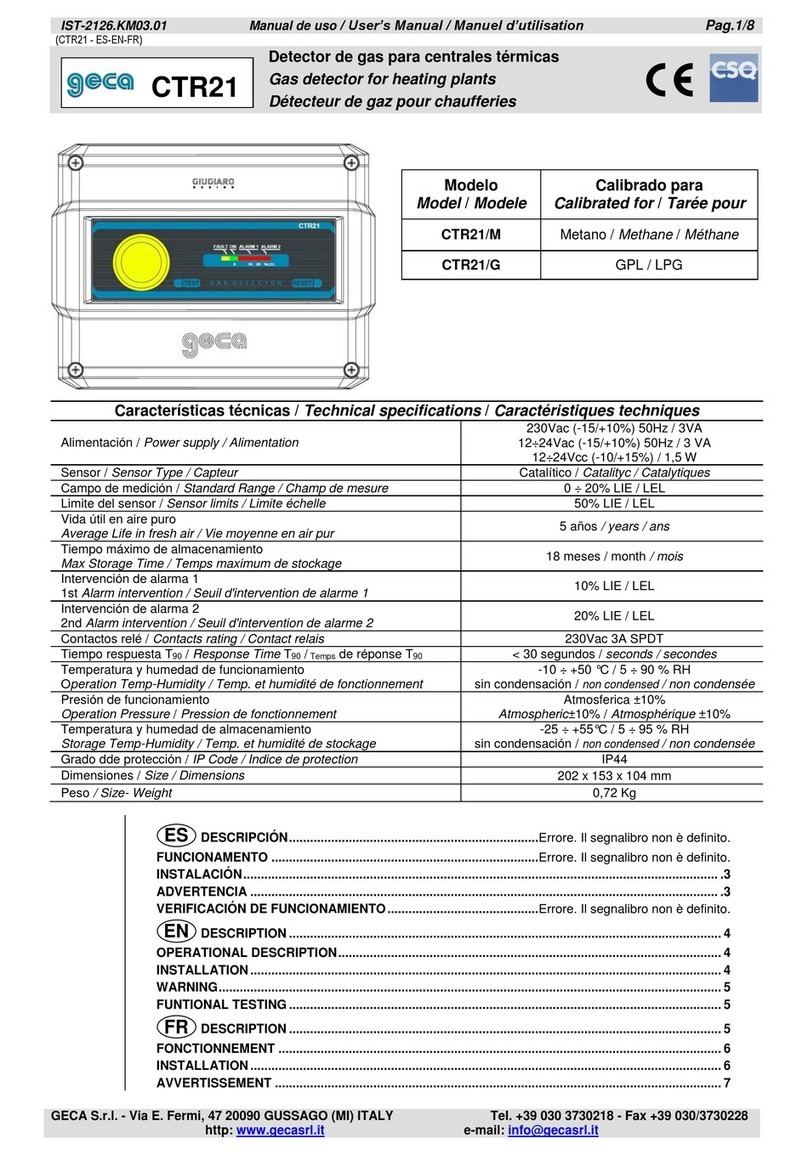
Geca
Geca CTR21/M User manual
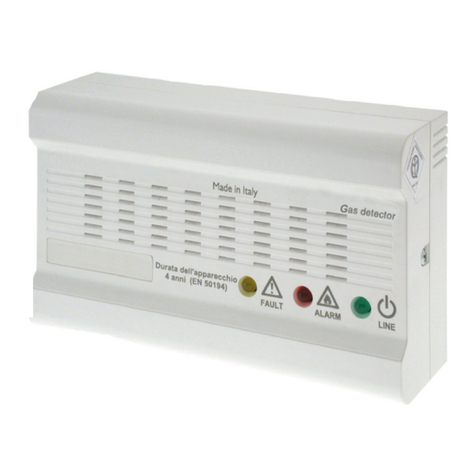
Geca
Geca GAMMA Series User manual
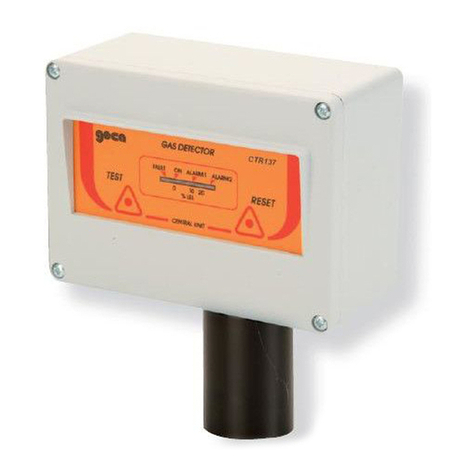
Geca
Geca CTR137M User manual
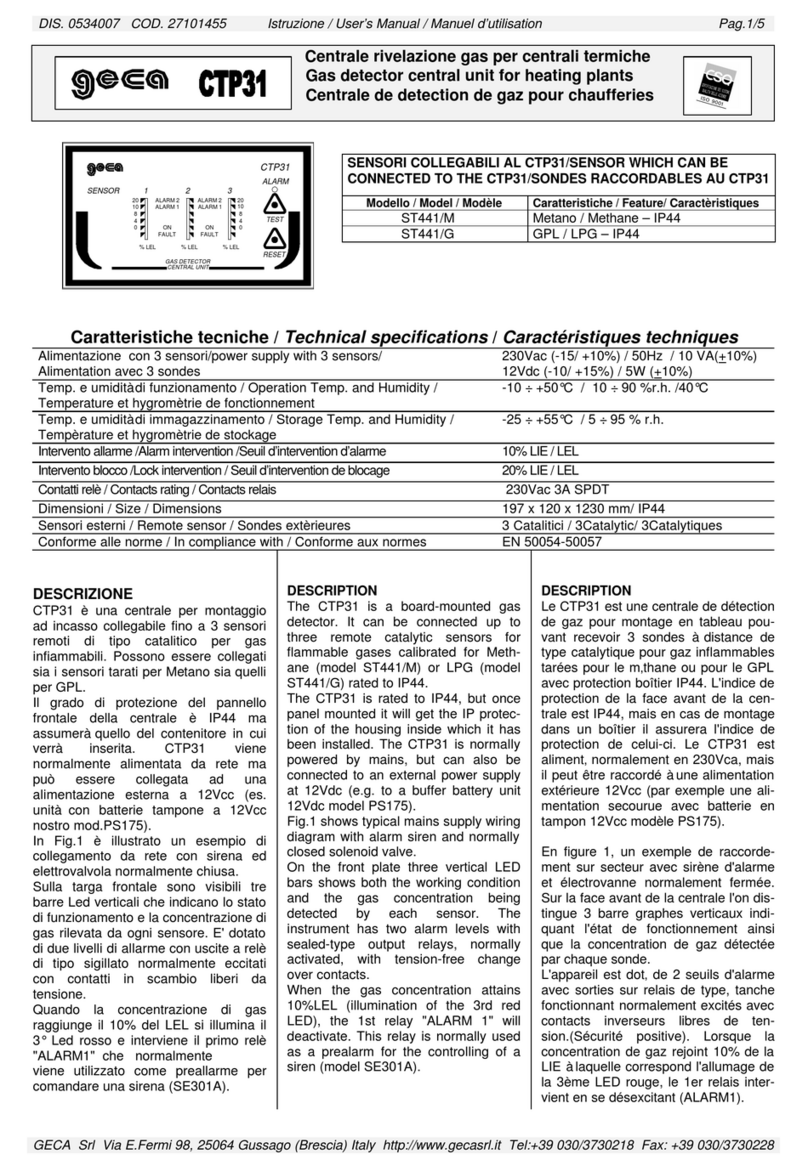
Geca
Geca CTP31 User manual

Geca
Geca SE235KM User manual
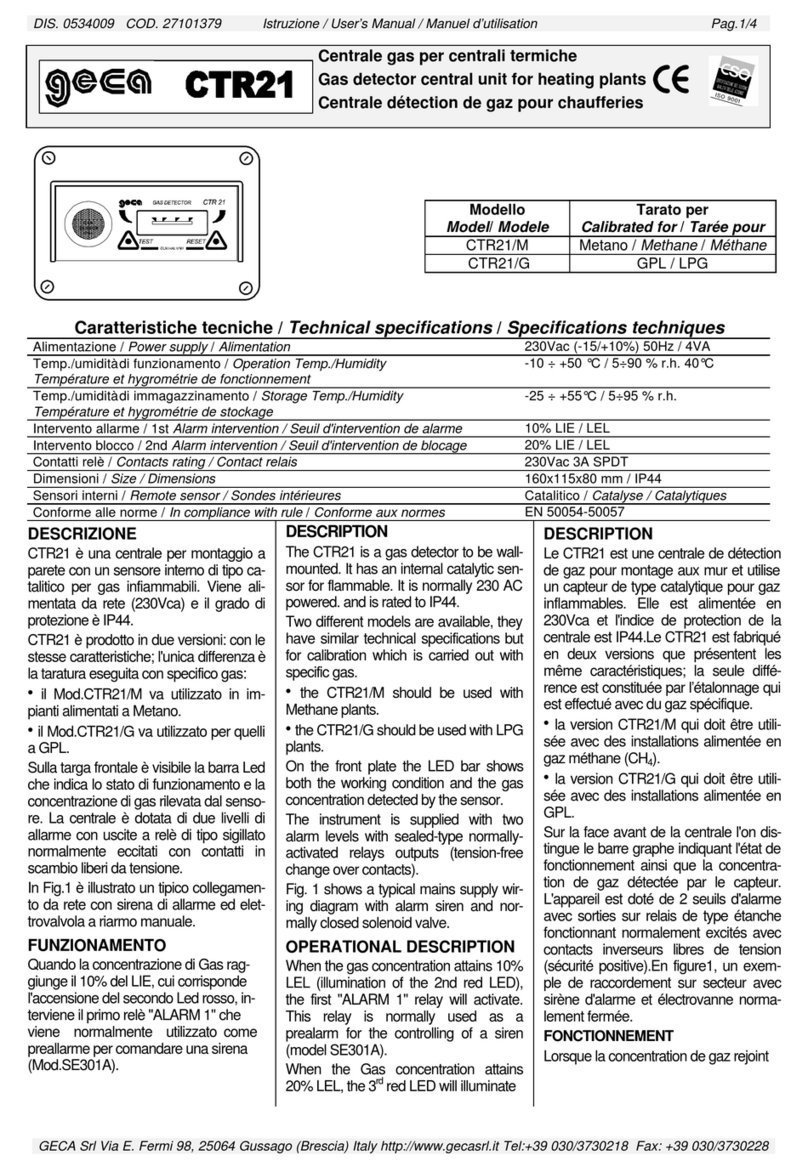
Geca
Geca CTR21/M User manual

Geca
Geca GAMMA Series User manual
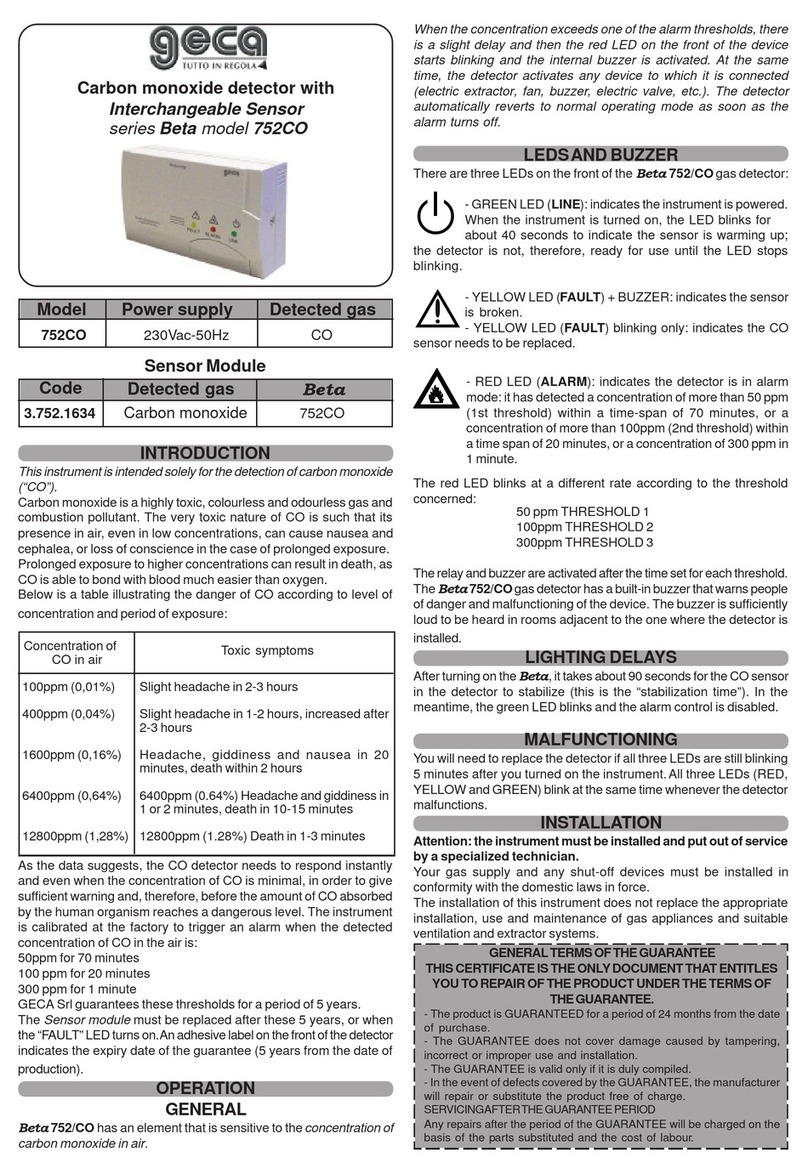
Geca
Geca Beta 752CO User manual
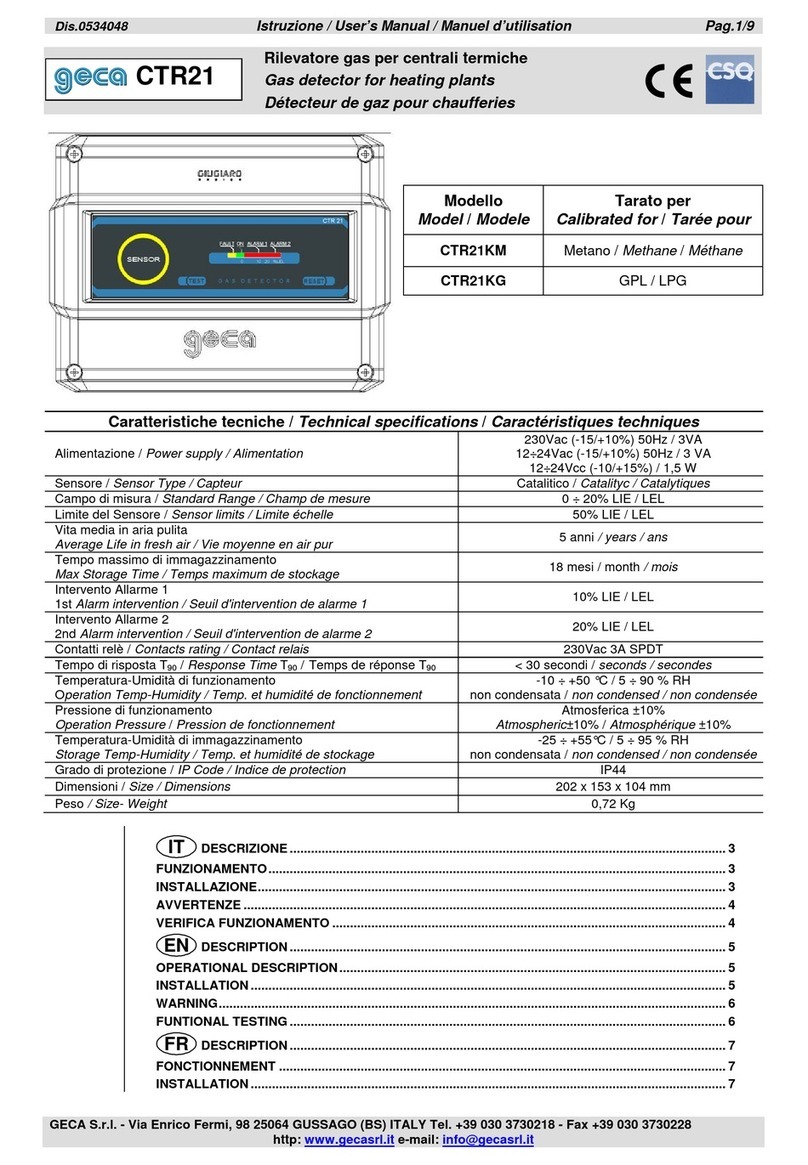
Geca
Geca CTR21 User manual
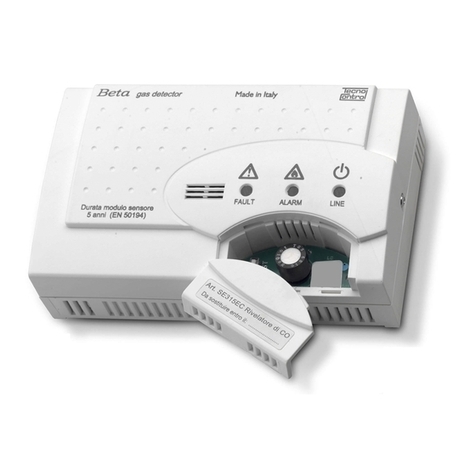
Geca
Geca Tecnocontrol Beta Series User manual
Popular Gas Detector manuals by other brands

OneTemp
OneTemp GDA 4350 operating manual
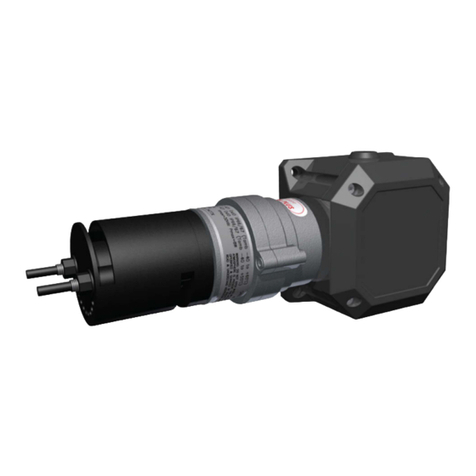
Consilium
Consilium Salwico GD True IR GS5000 Calibration Instruction
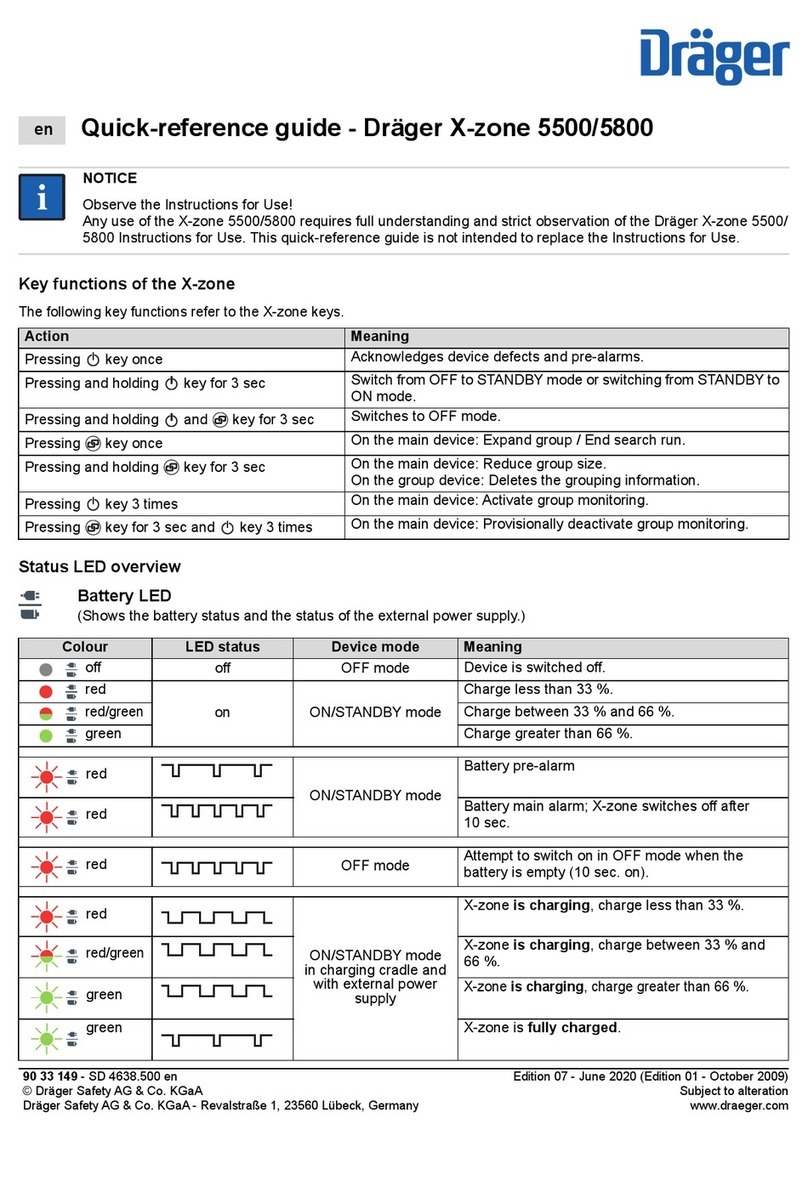
Dräger
Dräger X-zone 5500 Quick reference guide

Crowcon
Crowcon AGM 55 operating instructions
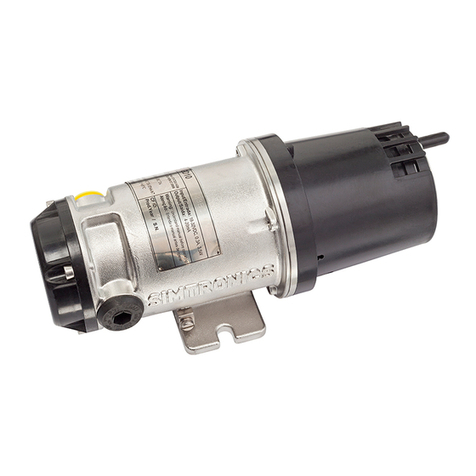
TELEDYNE OLDHAM SIMTRONICS
TELEDYNE OLDHAM SIMTRONICS Everywhereyoulook GD10-P00 operating manual
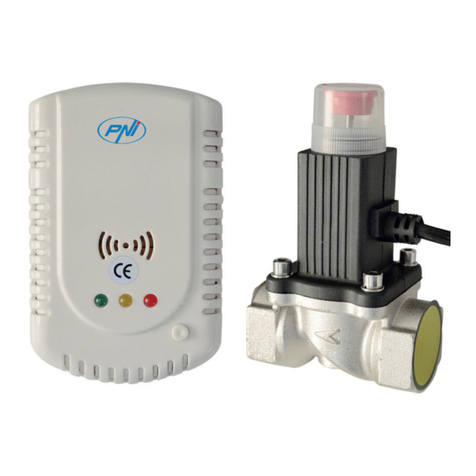
PNI
PNI GD-01 user manual
